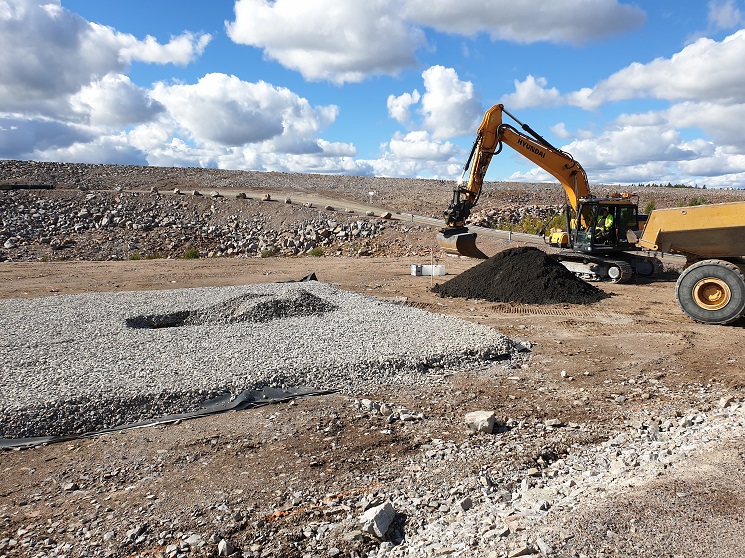Residual material from the forest industry could become new cover material for mining waste
Through a unique cross-industry collaboration, a new technology for covering mining waste has now been tested in demonstration scale at Boliden’s mine in Garpenberg, Sweden. The new technology involves a mixture of green liquor sludge, a residual material from the pulp industry, which can be an alternative to bentonite when improving the density of moraine. The collaboration is part of the Horizon 2020 project PaperChain – Now that the Paperchain test plot in Garpenberg is complete, we at Boliden are excited to see the result of this research cooperation with our partners. We will be closely monitoring its long-term performance and that hopefully it will meet our expectations, says Rodrigo Jr Embile, development engineer at Boliden.
The main objective when covering mining waste is to minimize the total oxygen penetration through the sealing layer to the underlying mining waste and thereby limit weathering and leaching of, for example, heavy metals. The mixture of green liquor sludge in the waterproofing layer means that what is now a residual material, in the future could have a new area of use, while the mining industry would have access to a material with positive environmental properties – Via the pulp mill’s chemical recycling process, green liquor sludge is formed which has a high water holding capacity and at the same time low water permeability. These are attractive properties in the construction of oxygen barriers, which are key functions of the mining industry’s waterproofing layer, says Gunnar Westin, business developer at RISE Processum.
In the PaperChain project, Boliden, Ragn-Sells, Ecoloop, Luleå University of Technology, RISE Processum in close collaboration with a number of pulp mills, have jointly developed the new technology to cover mining waste. Thereby, the entire business chain, from supplier to end customer, has been part of the collaboration. Ragn-Sells currently handles a number of different residual streams from, for example, pulp mills and has extensive experience in recycling and waste management. – An important part of our business is to find values and areas of use for materials and residual streams that are often considered waste. The technology of using green liquor sludge from pulp mills to create a waterproofing layer for mining waste is a good example of this, says Pär Odén, business project manager at Ragn-Sells.
The collaboration was born out of a concrete need, and has thus been developed in a very industry-oriented manner. An open approach across industry boundaries was also an important factor in order to take the step from tests in a lab environment to demonstration tests in the field. – A need was identified in the mining industry, at the same time there was a material from the forest industry with properties that can be tested against the specific requirements for a material to be considered suitable as an oxygen barrier. Through a Horizon 2020 project such as PaperChain, we have the opportunity to collaborate throughout the business chain and involve actors from every part, which has meant a faster development process and the opportunity to test the new technology on a large scale, says Gunnar Westin at RISE Processum. He believes that the PaperChain project shows that an open way of working creates new conditions for development. – What we have done is industrial symbiosis in a sharp case and we have learned an incredible amount from each other along the way.
Luleå University of Technology will now follow up and evaluate the functions of the covering technique that has been tested – It is very gratifying that we have been able to build a test site in demonstration scale and we will now be able to follow up and evaluate it. The main alternative to improving moraine with green liquor sludge today is a mixture of bentonite, which means a higher climate footprint and is costly. The test plot will be available for a long period of time, which is of great interest to our doctoral students. Several doctoral students have worked in the project and done the laboratory tests and material characterization that have formed the basis for the choice of material and the numerical modeling that has been performed to design the surface, says Christian Maurice, associate professor at Luleå University of Technology.

